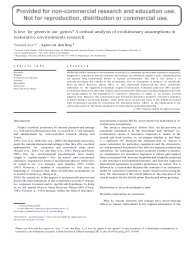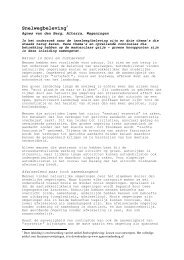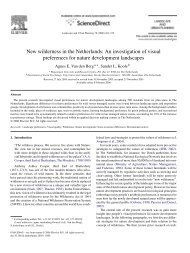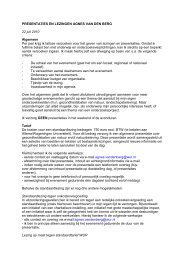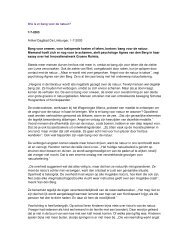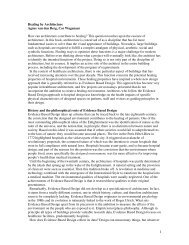healing environments in radiotherapy - Agnes van den Berg
healing environments in radiotherapy - Agnes van den Berg
healing environments in radiotherapy - Agnes van den Berg
Create successful ePaper yourself
Turn your PDF publications into a flip-book with our unique Google optimized e-Paper software.
Heal<strong>in</strong>g Environments <strong>in</strong> Radiotherapy Project Report<br />
Artworks can be expensive, which can make it difficult for hospitals that have to operate on a budget<br />
to implement many efforts to create a pleasant environment through decorations. UMC Gron<strong>in</strong>gen<br />
has found an <strong>in</strong>novative solution by offer<strong>in</strong>g their staff the opportunity to display their own artwork<br />
<strong>in</strong> the hospital. Furthermore, the hospital works with local artists to design decorations, and<br />
collaborates with art schools <strong>in</strong> mak<strong>in</strong>g the hospital environment more pleas<strong>in</strong>g. For <strong>in</strong>stance, the<br />
elevators were all designed by stu<strong>den</strong>ts of an art school <strong>in</strong> Gron<strong>in</strong>gen. This strategy allows the<br />
hospital to display a great variety of artworks, one of which is shown <strong>in</strong> figure 26.<br />
© KuiperCompagnions<br />
Figure 25: Sculpture at UMC Gron<strong>in</strong>gen<br />
Importantly, artworks are not only provided because they look nice, but because they offer<br />
distraction, which can be very helpful for seriously ill people who are deal<strong>in</strong>g with a lot of anxiety. To<br />
aid this distractive effect, artworks displayed at Parrish Medical Center are arranged like <strong>in</strong> a gallery,<br />
so that patients are <strong>in</strong>vited to stroll around to look at the artworks.<br />
In terms of offer<strong>in</strong>g other distractions, Mart<strong>in</strong>i Ziekenhuis Gron<strong>in</strong>gen also provides a large screen on<br />
which patients can watch sports events. Furthermore, every bed <strong>in</strong> the hospital has its own Personal<br />
Service Unit. This is a screen above the patients’ bed which has several applications. The patient can<br />
use it to listen to the radio, watch TV, go on the <strong>in</strong>ternet, use the telephone, and search for hospital<br />
<strong>in</strong>formation. Such extra ‘distractive’ services also enable the patient to keep <strong>in</strong> touch with the<br />
outside world through TV, <strong>in</strong>ternet and be<strong>in</strong>g able to talk to others (F. de Vos, De Vos<br />
Omgev<strong>in</strong>gspsychologie).<br />
Provid<strong>in</strong>g distractions is also very important <strong>in</strong> <strong>radiotherapy</strong> treatment rooms, s<strong>in</strong>ce patients have to<br />
lie still while be<strong>in</strong>g alone <strong>in</strong> a room with a big mach<strong>in</strong>e, which can feel threaten<strong>in</strong>g and produce<br />
anxiety. At the control hospital, this problem is addressed by decorat<strong>in</strong>g the ceil<strong>in</strong>gs of treatment<br />
rooms with a screen with many small holes, through which t<strong>in</strong>y sh<strong>in</strong><strong>in</strong>g lights simulate a starry sky<br />
(figure 28). Another method is to provide posters on the ceil<strong>in</strong>g, or to provide other visual<br />
distractions, such as light diffuser panels or virtual skylights (figure 29) (see for example<br />
www.theskyfactory.com or http://www.stratusdesigns.net/).<br />
32



